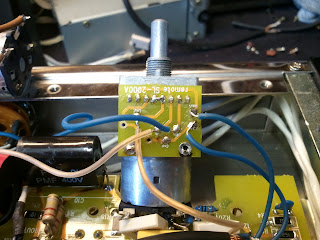| Brothers in Arms - Original Version |
Yesterday, I spun Why Worry Now and was again reaffirmed that this is the finest I have ever heard this recording on any of my systems. There were all sorts of nuances that were there and were evident, it's just that now instead of being casually resolved, such details are up front and center so to speak. Ambiance, for example, even on the digital version is far better and the decaying echoes much more lifelike, as compared to my prized analog version. Vocals are smoother and transients snappier without sounding artificial or over-emphasized. Things just sound right!
But this made me wonder: how many audiophiles are like this? How many actually cannot wait to get home from work and twist that good old volume knob knowing what awaits. I bet all of you are like this.
Sitting in your car and listening to the adequate playback system within, listening to your iPod while jogging around the park, or riding up the elevator - well, let's not go there. But coming home - that's what makes it all worthwhile. What awaits you in your magical audio parlor transports you to any event you wish to hear without leaving home. What other hobby can give you this amount of instant gratification?
So I've come to another conclusion about the characteristics or symptoms one must have to call yourself an audiophile. Here is what I've come up with so far:
10. Always on the lookout for or lusting after the newest and greatest piece of gear
9. Wanders into nearby audio salons during lunchtime
8. Eats dinner in front of your rig
7. Can't wait to demo your system to visitors
6. Carries a picture of your rig in your wallet
5. Loves swapping out pieces of equipment with other audiophiles
4. Subscribes to numerous audio-related publications, RSS feeds, and newsgroups
3. Goes on vacation to an electronics show
2. Dreams of new speakers and has nightmares about a house fire
1. Has a longing for sitting down in front of your system over almost any other activity
Yours for higher fidelity,
Philip Rastocny
Copyright © 2015 by Philip Rastocny. All rights reserved.
Philip Rastocny
I do not use ads in this blog to help support my efforts. If you like what you are reading, please remember to reciprocate, My newest title is called Where, oh Where did the Star of Bethlehem Go? It’s an astronomer’s look at what this celestial object may have been, who the "Wise Men" were, and where they came from. Written in an investigative journalism style, it targets one star that has never been considered before and builds a solid case for its candidacy.
- Althea: A Story of Love
- Build an Extreme Green Composter
- The Extreem Green Guide to Wind Turbines
- Build and Extreme Green Hot Water Solar Collector
- The Extreme Green Guide to Solar Electricity
- The Extreme Green Guide to Improving Mileage
- Meditation for Geeks (and other left-brained people)
- Build an Extreme Green Raised Bed Garden
- Build an Extreme Green Rain Barrel
- Build an Extreme Green Squirrel-Proof Bird Feeder
- Extreme Audio 1: House Wiring
- Extreme Audio 2: Line Filtering
- Extreme Audio 3: Chassis Leakage
- Extreme Audio 4: Interconnect Cables
- Extreme Audio 5: Speaker Wires
- Extreme Green Organic Gardening
- Extreme Green Organic Gardening 2012
- The Extreme Green Appliance Buying Guide
Copyright © 2015 by Philip Rastocny. All rights reserved.





 Extreme Audio 1: House Wiring
Extreme Audio 1: House Wiring

